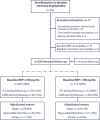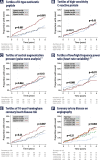B-type natriuretic peptide trumps other prognostic markers in patients assessed for coronary disease
- PMID: 30943979
- PMCID: PMC6448253
- DOI: 10.1186/s12916-019-1306-9
B-type natriuretic peptide trumps other prognostic markers in patients assessed for coronary disease
Abstract
Background: Risk prediction for patients with suspected coronary artery disease is complex due to the common occurrence of prior cardiovascular disease and extensive risk modification in primary care. Numerous markers have the potential to predict prognosis and guide management, but we currently lack robust 'real-world' evidence for their use.
Methods: Prospective, multicentre observational study of consecutive patients referred for elective coronary angiography. Clinicians were blinded to all risk assessments, consisting of conventional factors, radial artery pulse wave analysis, 5-minute heart rate variability, high-sensitivity C-reactive protein and B-type natriuretic peptide (BNP). Blinded, independent adjudication was performed for all-cause mortality and the composite of death, myocardial infarction or stroke, analysed with Cox proportional hazards regression.
Results: Five hundred twenty-two patients were assessed with median age 66 years and 21% prior revascularization. Median baseline left ventricular ejection fraction was 64%, and 62% had ≥ 50% stenosis on angiography. During 5.0 years median follow-up, 30% underwent percutaneous and 16% surgical revascularization. In multivariate analysis, only age and BNP were independently associated with outcomes. The adjusted hazard ratio per log unit increase in BNP was 2.15 for mortality (95% CI 1.45-3.19; p = 0.0001) and 1.27 for composite events (1.04-1.54; p = 0.018). Patients with baseline BNP > 100 pg/mL had substantially higher mortality and composite events (20.9% and 32.2%) than those with BNP ≤ 100 pg/mL (5.6% and 15.5%). BNP improved both classification and discrimination of outcomes (p ≤ 0.003), regardless of left ventricular systolic function. Conversely, high-sensitivity C-reactive protein, pulse wave analysis and heart rate variability were unrelated to prognosis at 5 years after risk modification and treatment of coronary disease.
Conclusions: Conventional risk factors and other markers of arterial compliance, inflammation and autonomic function have limited value for prediction of outcomes in risk-modified patients assessed for coronary disease. BNP can independently identify patients with subtle impairment of cardiac function that might benefit from more intensive management.
Trial registration: Clinicaltrials.gov, NCT00403351 Registered on 22 November 2006.
Keywords: B-type natriuretic peptide; Coronary angiography; Coronary artery disease; Mortality; Risk.
Conflict of interest statement
Ethics approval and consent to participate
The ARM-CAD Study was approved by Ethics Committees from Monash University, Melbourne, Australia (2006/831MC) and The Alfred Melbourne, Australia (38/07).
All patients provided written informed consent.
Consent for publication
Not applicable – all original data.
Competing interests
MDF reports grants from Novartis and personal fees from AstraZeneca, Novartis and Pfizer, all outside the submitted work. DA has received speakers’ honoraria from Roche Diagnostics and Siemens Diagnostics, outside the submitted work. PC reports personal speaking honoraria from Menarini, AstraZenica, Bayer, Itamar Medical, Abbott and Ferring Pharmaceuticals, all outside the submitted work. The other authors declare that they have no competing interests.
Publisher’s Note
Springer Nature remains neutral with regard to jurisdictional claims in published maps and institutional affiliations.
Figures




Similar articles
-
B-Type Natriuretic Peptide Assessment in Patients Undergoing Revascularization for Left Main Coronary Artery Disease: Analysis From the EXCEL Trial.Circulation. 2018 Jul 31;138(5):469-478. doi: 10.1161/CIRCULATIONAHA.118.033631. Circulation. 2018. PMID: 29666071 Clinical Trial.
-
Role of B-Type Natriuretic Peptide and N-Terminal Prohormone BNP as Predictors of Cardiovascular Morbidity and Mortality in Patients With a Recent Coronary Event and Type 2 Diabetes Mellitus.J Am Heart Assoc. 2017 May 29;6(6):e004743. doi: 10.1161/JAHA.116.004743. J Am Heart Assoc. 2017. PMID: 28554908 Free PMC article. Clinical Trial.
-
C-reactive protein and brain natriuretic peptide as predictors of adverse events after lower extremity endovascular revascularization.J Vasc Surg. 2014 Sep;60(3):652-60. doi: 10.1016/j.jvs.2014.03.254. Epub 2014 Apr 29. J Vasc Surg. 2014. PMID: 24795153 Free PMC article.
-
Aldosterone, mortality, and acute ischaemic events in coronary artery disease patients outside the setting of acute myocardial infarction or heart failure.Eur Heart J. 2012 Jan;33(2):191-202. doi: 10.1093/eurheartj/ehr176. Epub 2011 Jun 30. Eur Heart J. 2012. PMID: 21719456
-
Translational phases of evidence in a prognostic biomarker: a systematic review and meta-analysis of natriuretic peptides and the prognosis of stable coronary disease.Heart. 2012 Apr;98(8):615-22. doi: 10.1136/heartjnl-2011-300862. Epub 2012 Mar 3. Heart. 2012. PMID: 22388698
Cited by
-
The Expression Significance of LPa, BNP, and McP-1 in CHD Patients and Their Relationship with Echocardiographic Parameters.Contrast Media Mol Imaging. 2022 Aug 27;2022:5165203. doi: 10.1155/2022/5165203. eCollection 2022. Contrast Media Mol Imaging. 2022. Retraction in: Contrast Media Mol Imaging. 2023 Sep 27;2023:9854816. doi: 10.1155/2023/9854816. PMID: 36101804 Free PMC article. Retracted.
-
Post-mortem examination of high mortality in patients with heart failure and atrial fibrillation.BMC Med. 2022 Oct 5;20(1):331. doi: 10.1186/s12916-022-02533-8. BMC Med. 2022. PMID: 36195871 Free PMC article.
-
A systematic comparison of short-term and long-term mortality prediction in acute myocardial infarction using machine learning models.BMC Med Inform Decis Mak. 2025 Jun 5;25(1):208. doi: 10.1186/s12911-025-03052-1. BMC Med Inform Decis Mak. 2025. PMID: 40474184 Free PMC article.
-
Using the Super Learner algorithm to predict risk of major adverse cardiovascular events after percutaneous coronary intervention in patients with myocardial infarction.BMC Med Res Methodol. 2024 Mar 8;24(1):59. doi: 10.1186/s12874-024-02179-5. BMC Med Res Methodol. 2024. PMID: 38459490 Free PMC article.
-
Association Between First-Phase Left Ventricular Ejection Fraction and Severity of Coronary Artery Stenosis and Changes With Interventional Treatment.J Am Heart Assoc. 2025 Apr 15;14(8):e040901. doi: 10.1161/JAHA.124.040901. Epub 2025 Apr 10. J Am Heart Assoc. 2025. PMID: 40207536 Free PMC article.
References
-
- Bottle A, Mozid A, Grocott HP, Walters MR, Lees KR, Aylin P, et al. Preoperative risk factors in 10 418 patients with prior myocardial infarction and 5241 patients with prior unstable angina undergoing elective coronary artery bypass graft surgery. Br J Anaesth. 2013;111:417–423. doi: 10.1093/bja/aet107. - DOI - PMC - PubMed
Publication types
MeSH terms
Substances
Associated data
Grants and funding
LinkOut - more resources
Full Text Sources
Medical
Research Materials

